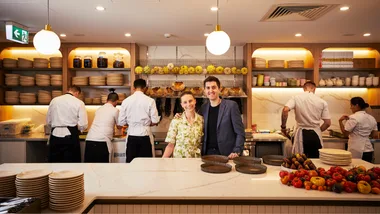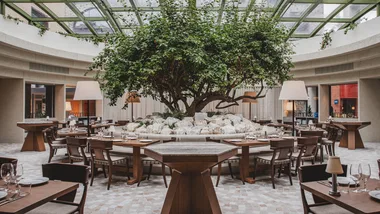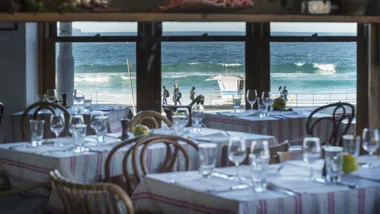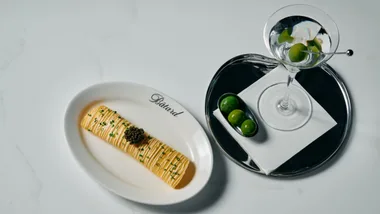In 1955 Ion Nicolades decided to modernise the café his grandfather James Sigalas had opened in Melbourne’s Bourke Street around 1903. The city was in a frenzy of sprucing up ahead of the Olympic Games and Nicolades thought the double-fronted Anglo-American Café, with its soda fountains and confectionery counter, needed a new look. He contracted sculptor Clement Meadmore to design the interior and artist Leonard French (who would go on to design the stained-glass ceiling at the National Gallery of Victoria) to paint a series of striking murals entitled The Legend of Sinbad the Sailor.
Renamed the Legend Café, its riot of Modernist colour, terrazzo flooring, coloured stools and diagonally patterned fluorescent lighting raised the bar for café design in Australia and attracted Melbourne’s hippest crowd, including artists such as Clifton Pugh and Arthur Boyd. The frontage could be completely opened to the street so the sound of the soda fountains and scent of espresso became part of the design, and enveloped passersby. The Legend looked Italian and American. It served milkshakes, sundaes and cappuccino. It was at the vanguard of a new breed of technology-forward cafés that had been popping up across Australia – all owned and run by Greeks.

Capitol Picture Theatre Milk Bar, Wagga Wagga, mid-1930s.
The Greek influence on Australia’s dining scene today is clear. Dishes such as souvlaki, taramasalata, loukoumades, saganaki, moussaka, spanakopita and more are part of the national diet and the restaurant scene offers all manner of Greek food experiences from street food to high-end fine-diners.
But the embrace of Greek cuisine is a relatively recent phenomenon. Restaurants serving Greek food became visible in the 1970s and ’80s, but there were generations of Greek-run places before then, stretching as far back as the gold rushes of the 1800s. And as a recently released book by documentary photographer Effy Alexakis and historian Leonard Janiszewski points out, these restaurants have had a major and lasting influence on the way Australians eat, drink and socialise. So much so that you could say the Greeks were pioneering players in the development of the Australian restaurant scene.

Canberra Dining Rooms and Oyster Saloon, 1914.
“During the twentieth century Greek-run cafés, milk bars, soda and sundae parlours, and oyster saloons became iconic catering enterprises where many Australians, in both rural and urban settings, met often, ate regularly and at times partied hard,” writes Janiszewski in his introduction to Greek Cafés & Milk Bars of Australia. “They were a social focus for many communities across the country.”
It’s not difficult to understand the allure of these places, particularly in country towns where they were often the only place to get something to eat from breakfast through to dinner. The phrase “I’ll meet you at the Greeks” that became common from the 1940s into the ’60s showed how central these cafés became to a town’s social life.

Crethar’s in Lismore, 1939
But it wasn’t just about convenience. With their cosmopolitan names – Niagara, Hollywood, Olympia, Elysian, Golden Gate, Monterey, New York – and often elaborate designs that channelled Hollywood glamour through chrome curves, etched glass, booth seating, gleaming soda fountains and milkshake machines, jukeboxes and air-conditioning, these places, as Janiszewski points out, offered an American dream. Along with the all-inclusive approach that saw them become social hubs, they brought a shiny New World modern Americana to a country that had previously taken most of its cultural and culinary cues from decidedly Old World Britain.

The Golden Star Milk Bar, Hay Street, Perth, in the mid-1930s.
Actor and writer Lex Marinos grew up in the 1950s living above the Bridge Café in Wagga Wagga, one of a series of cafés his grandparents owned in the country and where his parents worked with his grandparents and his aunts. He says there were about 15 cafés owned by Greeks in the town at the time, many of which had opened to cater to US servicemen stationed at a nearby military base during World War II.
The Bridge had a jukebox, sold hamburgers, milkshakes and cigarettes, and very much followed an American style.
“It was a time when America seemed progressive,” he says. “It was energetic, young and prosperous and it seemed to have more in common with Australia than Britain. When I was growing up, Britain was recovering from being bombed and everybody was on rations. America had rock ‘n’ roll.”

Kanis’s Oyster Café, Richmond, 1929.
The food, on the other hand, remained distinctly Anglo. The American influences – the shakes, the sodas, the sundaes – were fitted around menus that read in an eyeglazingly similar way: mixed grill, steak and eggs, chops and eggs, ham and eggs, sausages and eggs, toasted sandwiches, and meat pies. Australians were not interested in Greek food so the Greek owners didn’t present their indigenous cuisine.
Funnily enough, the Greek hospitality crowd (or “milk bar aristocracy” as Marinos says they were sometimes called) had actually been driving this Australian desire for Americana since the late 19th century.
In Greek Cafés & Milk Bars of Australia, Janiszewski says that a recession in Greece in the 1890s saw many Greeks migrate to the United States where they “became heavily involved in the food catering business”, marrying the inclusive social spirit of the taverna and the kafenia with American technology like soda fountains and neon lighting.
Some of these people then migrated to Australia looking for work opportunities. They bought existing businesses, like oyster saloons, and began to update them, adding hissing, bubbling soda fountains and turning them into soda parlours. As technology improved, these Greek migrants started serving American-style ice-cream and milk chocolate alongside the ever-popular flavoured sodas. After the modern milkshake machine was invented in the early 1930s, more cafés turned to the American-style drugstore/milk bar model.

Astoria Café, Newcastle, late 1940s
An early adoptor was Greek immigrant Joachim Tavlarides, known as Mick Adams. He opened a series of Black & White milk bars around the country that pioneered the stand-up, quick-service style that became immensely popular. He opened his first Black & White in Martin Place in Sydney in 1932 and sold 5,000 milkshakes on the first day. It went on to serve around 27,000 customers a week at the height of its popularity and, in the wake of its success, more than 4,000 milk bars had opened around Australia by the end of 1937.
While the influence of these Greek immigrant businesses was remarkable, the fact that the businesses looked American, the owners anglicised their names, hired non-Greek waitstaff and served food that was distinctly British or American seems to show that running a milk bar or “American café” was as much about survival as it was about choice. They masked their heritage to prosper financially. Oddly enough, though there was often racist hostility towards the owners, people kept coming because these were the best and most modern (and sometimes only) places to eat or grab a shake.
As Janiszewski puts it, “the same guy who would stagger out of the six o’clock swill and come into the café and abuse the owner would come in on another day with his family and have a nice meal there”.
As well as providing employment and financial security to new immigrants who struggled to find work elsewhere, the Greek milk bars and cafés also acted as a place for them to socialise.

A Greek social gathering at Silver Star Café, Cootamundra, 1940s.
“From an early age I had an understanding that there were two worlds,” says Marinos. “The first was when the shop was open, the day-to-day world of commerce, which brought the outside in to us. The second existed when the shop was closed, especially on Sunday nights when the shop closed early.”
On those Sundays there would be the kind of Greek food we take for granted today: lamb baked with lemon and garlic, cabbage rolls, spinach and beans in olive oil and lemon juice, olives, feta, yoghurt. Greek was spoken, Greek music played, wine drunk, there was dancing. From today’s perspective, it sounds like just another night at the local taverna.
Interestingly, Greek Cafés & Milk Bars of Australia sprung from a project Alexakis and Janiszewski have been working on since the 1980s, documenting the lives of Greek-Australians in reaction to the “always folkloric, stereotypic way of looking at Greeks in Australia – they were either dancing in national costume or in a café”.

Photographer Effy Alexakis and historian Leonard Janiszewski
But during the course of their research – which includes 1,800 interviews and 100,000 images, many copied from private family albums – they became struck by how prominent and common cafés and milk bars were in the Greek-Australian migrant experience. And, increasingly, how influential these places were on the general Australian experience of eating out. Looking through the book, it’s plain to see that these Greek pioneers were central to the development of the Australian restaurant scene of today.
Alexakis also noticed how quickly these places were disappearing as the next generation, given tertiary education by their café-owning parents and grandparents, moved on to other lines of work. She was determined to capture this important part of Australian history before it vanished.
Only a handful of these places survive, so it’s important that the legacy of the lost places is remembered, too. Greek Cafés & Milk Bars of Australia is a good place to start.
Greek Cafés & Milk Bars of Australia by Effy Alexakis and Leonard Janiszewski (Halstead Press, pbk, $49.95) is available from cafesandmilkbars.com.au










